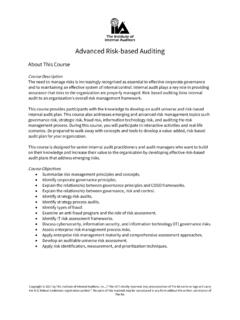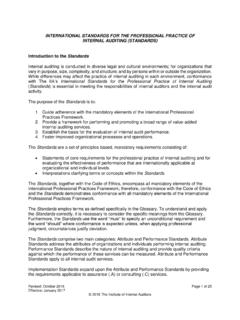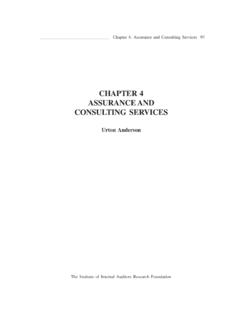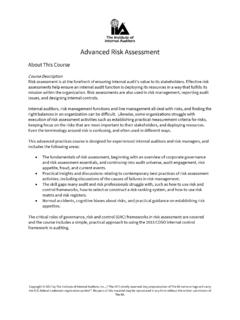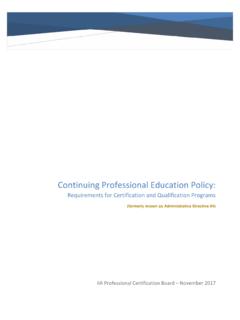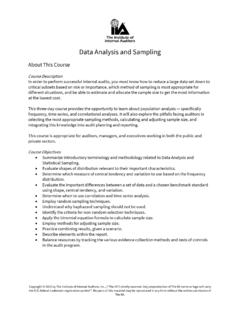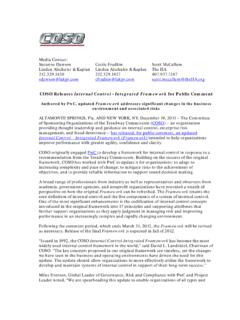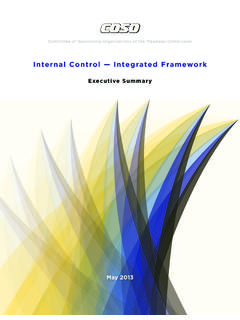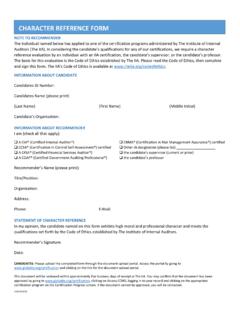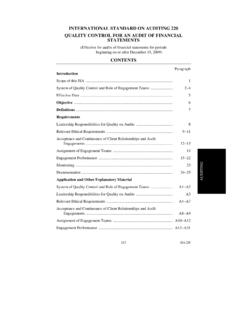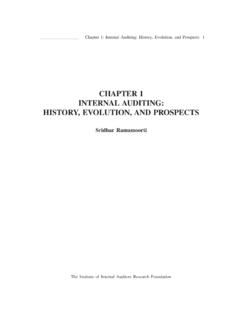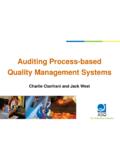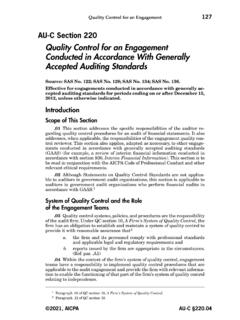Transcription of The Framework for Quality Assurance
1 The Framework for Quality Assuranceov e r v i eWA critical asset for an internal audit activity is its credibility with stakeholders. To provide cred-ible assistance and constructive challenge to management, internal auditors must be perceived as professionals. Professionalism requires conforming to a set of professional standards. This chapter provides an overview of The IIA s International Standards for the Professional Practice of Internal auditing and the other elements that make up the International Professional Practices Framework (IPPF). It explains how each has evolved as the profession has matured, and how their application should be tailored to each organization without compromising conformance with the Standards.
2 In particular, it presents and discusses the 1300 series of the Standards that deals specifically with Quality a n d a r d s re q u i r e qu A l i t y As s u rA n C e Fo C u sChief audit executives (CAEs) need Assurance that their internal audit activity and each member of their staff conform to all mandatory elements of the IPPF, and they need to demonstrate this conformance to their stakeholders. The only way to meet these expectations is with a comprehensive Quality Assurance and improvement program (QAIP) that includes ongoing monitoring of performance, periodic internal assessments, external assessments conducted by a qualified, independent assessor or assessment team from outside the organization, and communication of the and Other Professional Guidance Have Evolved With the ProfessionThe steadily expanding scope and global reach of internal auditing is reflected in and fostered by changes in the Standards and professional guidance.
3 Changes occurred in the Standards effective January 1, 2017, and contribute to the update to this manual. A significant change in professional guidance occurred in 1999 with a new Definition of Internal auditing and the development of the Professional Practices Framework , which became the IPPF in 2009. The IPPF was further updated and expanded in July 2015, and again in 2017. Evaluating risk management and governance processes is much more challenging and meaningful than control alone. It requires internal audit to operate at a higher, more strategic level. To operate at this level, internal auditors need a higher level of credibility with their Assurance Has Evolved With the StandardsThe original Standards (1978) stated, The director of internal auditing should establish and maintain a Quality Assurance program that includes an external Quality assessment (EQA) every three years.
4 The three-year time frame was chosen to be in line with guidance from the Government Accountability Office ( GAO). In the 2002 revision of the Standards, The IIA changed the time frame to every five years, as this was considered more appropriate for an internal audit Assessment Manual for the Internal Audit Activity10th e i p pF The requirements and characteristics of Quality in an internal audit activity are defined by the IPPF, which consists of mandatory and recommended guidance, all provided within the context of the Mission of Internal Audit as defined in the IPPF. Mandatory Guidance Mandatory guidance is considered essential for the professional practice of internal auditing .
5 Mandatory guidance is submitted for review by the entire global profession through the expo-sure draft process. It consists of four elements: Core Principles: The Core Principles for the Professional Practice of Internal auditing are the foundation for the IPPF and support internal audit effectiveness. Definition of Internal auditing : Internal auditing is an independent, objec-tive Assurance and consulting activity designed to add value and improve an organization s operations. It helps an organization accomplish its objectives by bringing a systematic, disciplined approach to evaluate and improve the effec-tiveness of risk management, control, and governance processes.
6 Code of Ethics: The Principles and Rules of Conduct of the Code of Ethics define ethical behavior for a professional internal 1 The Framework for Quality Assurance Standards: The Standards are the central criteria that define the attributes and characteristics of performance for an internal audit activity, including the requirements for a QAIP. Recommended Guidance Recommended guidance is endorsed by The IIA through a formal approval process. It describes practices for the effective implementation of the Core Principles, the Definition of Internal auditing , the Code of Ethics, and the Standards. Recommended guidance helps internal auditors understand and apply the Standards and may provide insight into going beyond conformance to a higher level of adding value, or addressing issues of concern not related to a specific standard.
7 Recommended guidance is described in terms of implemen-tation guidance and supplemental guidance and is available to IIA members on The IIA s websites: and Implementation Guidance: Implementation Guides exist for each standard. They are intended to provide guidance to internal audit practitioners with regard to conformance with the Standards. Supplemental Guidance: Supplemental guidance provides detailed guid-ance for conducting internal audit activities. Supplemental guidance includes topical areas, sector-specific issues, as well as processes and procedures, tools and techniques, programs, step-by-step approaches, and examples of deliver-ables. Examples of supplemental guidance currently include Practice Guides, Global Technology Audit Guides (GTAGs), and Guides to the Assessment of IT Risk (GAIT).
8 Quality Assurance and Improvement ProgramStandard 1300 Quality Assurance and Improvement Program is included in full because it defines the requirements for a QAIP. Consult The IIA s website for the most current version of the Standards and for recommended guidance. Chapter 2 of this manual describes the requirements and considerations for establishing a QAIP. Chapters 3, 4, and 5 describe the requirements and considerations for performing internal assessments, a full external assess-ment, and a self-assessment with independent validation, Assessment Manual for the Internal Audit Activity121300 Quality Assurance and Improvement ProgramThe chief audit executive must develop and maintain a Quality Assurance and improvement program that covers all aspects of the internal audit activity.
9 Interpretation:A Quality Assurance and improvement program is designed to enable an evaluation of the internal audit activity s conformance with the Standards and an evaluation of whether internal auditors apply the Code of Ethics. The program also assesses the efficiency and effectiveness of the internal audit activity and identifies opportunities for improvement. The chief audit executive should encourage board oversight in the Quality Assurance and improvement Requirements of the Quality Assurance and Improvement Program The Quality Assurance and improvement program must include both internal and external assessments. 1311 Internal AssessmentsInternal assessments must include: Ongoing monitoring of the performance of the internal audit activity.
10 Periodic self-assessments or assessments by other persons within the organiza-tion with sufficient knowledge of internal audit :Ongoing monitoring is an integral part of the day-to-day supervision, review, and measurement of the internal audit activity. Ongoing monitoring is incorporated into the routine policies and prac-tices used to manage the internal audit activity and uses processes, tools, and information considered necessary to evaluate conformance with the Code of Ethics and the Standards. Periodic assessments are conducted to evaluate conformance with the Code of Ethics and the 1 The Framework for Quality AssuranceSufficient knowledge of internal audit practices requires at least an understanding of all elements of the International Professional Practices External AssessmentsExternal assessments must be conducted at least once every five years by a qualified, inde-pendent assessor or assessment team from outside the organization.
